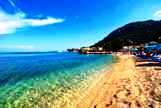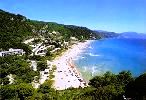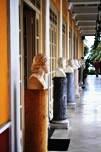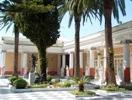
Towards the south end of Corfu town is gently-curving Garitsa bay, whose shore is an ideal place for a stroll or a trip in a horse-drawn carriage. At the south end of Garitsa bay stands the Kanoni promontory, where most of the oldest monuments of Corfu are concentrated. Those closest to the town are the circular cenotaph of Menecrates and the church of Sts Jason and Sosipater. Not far away is the Palaiopoli district, where the ancient city of Corcyra stood. Further to the west, near the ancient Hyllaean harbour, are the remains of the temple of Artemis, while in Palaiopoli itself, by the entrance to Mon Repos, we can see what has remained of the Early Christian basilica of St Cercyra.


Close to Gastouri, 13 km. south of Corfu town, is Benitses, once, a small village but in recent years a centre for tourist development and a place whose night-life is renowned. The village stands in an area rich in orange and lemon trees and has a pebble beach. The remains of a Roman baths have been excavated in the area, and a Roman villa (of the third century AD) with a mosaic floor has come to light. Moraitika, another former fishing village, is now equally cosmopolitan in atmosphere. It is 7 km. south of Benitses and has a sandy beach.

Argyrades, 33 km. south of Corfu town, is one of the largest villages on the island and is interesting for its traditional architecture, in which many features dating back to the Venetian period can be distinguished. To the southwest is the long and attractive beach of Ayios (Agios) Yeorgios, but the whole area is wellknown for its beaches with their fine sand (including Marathia, Maltas near the village of Perivoli, and Gardenias near Vitalades). To the northwest of Argyrades, at a distance of 3 km., is the pretty fishing village of Petriti, where there is almost always fresh fish to be had. However, the largest community in south Corfu is Lefkimmi, 42 km. from Corfu town, which has a population of 5,000.

A road leads off from the bridge at Mesoggi to Ayios (Agios) Matthaios, and from it another turning brings us to the spot known as Gardiki. The principal attraction of Gardiki is a ruined Byzantine castle of the thirteenth century, octagonal in shape and with eight imposing towers. Two of the towers have interesting ornamental brickwork built into their walls, and here and there throughout the entire structure are architectural members from ancient buildings that once stood round about. Another turning before we reach Ayios (Agios) Matthaios crosses the slopes of the hill called Mathios. The hill is also known as the Gamelion Horos ('Wedding Mountain') because of the tradition that the marriage of Alcinous and Arete took place there. On the hill stands the monastery of Christ Pantokrator, some 500 metres from which is the Cave of Pelaou, which is believed to run as far as the sea. Inside the cave, traces of human habitation in the Palaeolithic era have been discovered. Ayios (Agios) Matthaios (22.5 km. from Corfu town) is a large village on a naturally amphitheatrical site, surrounded by a wood of oak trees and olives.
Ano ('upper') Pavliana is an inland village which stands on a verdant hill. Kato ("lower') Pavliana is very close at hand. In the church of St Demetrius which has a well-attended feast day on 26 October is an interesting iconostasis carved out of stone by the Kardamis family of sculptors. Another sculpture by the same family is to be found in the village of Garouna (Ano and Kato), which has a particular tradition in this art. The statue, created by Stefanos Kardamis in memory of his late father, depicts that self-taught stonemason. Garouna, also known for its carpet weaving workshop, is the venue - in mid-August - of lectures, performances, competitions and mountain-climbing contest.

Pelekas, an old style village 13.5 km. to the south-west of Corfu town, stands on the top of an idyllic hill with an amazing view. At the highest point of the village is a flat area called 'the Kaiser's throne', since Wilhelm II often made his way to Pelekas to admire the unforgettable sunset. The view at sundown out to sea, over the interior of the island and even as far as Corfu town is a unique experience. Pelekas is something of a resort area, thanks partly to the fine beach not far away at Glyfada (3 km.).

Gastouri is a small village close to the sea, 11.5 km. south of Corfu town. In the village square, beneath a tree, is the socalled Spring of Elizabeth, which has now run dry. The whole area is connected with the Empress Elizabeth of Austria, often known as Sissy, whose summer palace, the famous Achilleio, stands a mere two kilometres from Gastouri. The life of the Empress Elizabeth (1837-1898) has repeatedly been the subject of novels and films, as a result of her beauty, her strength of character, and the story of her love for the Emperor Franz Josef. Elizabeth married the Austrian Emperor in 1854, and the couple had two daughters, Sophia and Gisela, and a son called Rudolf. But Elizabeth's liberal notions displeased her mother-in-law, the Archduchess Sophia, who personally took in hand the upbringing of the royal children and denied their mother access to them.






The Dying Achilles now stands on the terrace in front of, and slightly below, the peristyle with the Muses. It is a marble statue by the German sculptor Ernst Herder, made to a commission by Elizabeth in 1884, and originally located in her palace in Vienna. Achilles here is semirecumbent, almost nude, wearing his helmet and attempting to draw the fatal arrow shot by Paris from his heel. This outstanding work, now the established emblem of the Achilleio, is notable for the skill with which the artist has rendered the hero's anguish and pain as death approaches.